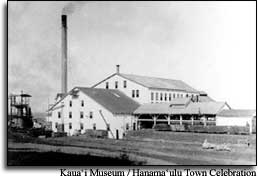Hanama’ulu residents are set to present a major community celebration and plantation camp reunion on Saturday, July 16 and Sunday, July 17. The two-day event is to have a parade featuring a Marine Corp color guard, the Hawai’i Army 111th
Hanama’ulu residents are set to present a major community celebration and plantation camp reunion on Saturday, July 16 and Sunday, July 17.
The two-day event is to have a parade featuring a Marine Corp color guard, the Hawai’i Army 111th Marching Band, the Hawaii Army National Guard Marching Unit, the 154 the Air Control Squadron and other military groups; speeches by politicians, Mayor Bryan Baptiste and Councilwoman JoAnn Yukimura; a ceremony honoring “old-timers” of Hanama’ulu; and performances by a Hawaiian halau, Japanese and Filipino dance groups and a band of senior citizens.
The event also includes an ethnic food festival, a booth featuring memorabilia about Hanama’ulu town and plantation camp houses, floats representing senior citizens and churches, a craft fair and the publication of a special souvenir book.
The event was initially intended to bring together families and longtime residents, and to pay tribute to more than 100 years of plantation life at Hanama’ulu. Many of the town’s residents worked for Lihue Plantation during Kaua’i’s Plantation Era, and the town once had its own sugar mill, located near where Aloha Lumber operates today.
But community leaders decided to expand that theme to attract more participants.
Fittingly, a committee created a motto for the event, “Remembering the Past…Celebrating the Present…Embracing the Future.”
Community leaders wanted to use the celebration as a way to tell more people about the past, present and future of Hanama’ulu Town and its plantation camp heritage, said program organizer Eddie Sarita, who is Hanama’ulu resident.
At 10 a.m. on July 16, a convoy of “ethnic” floats, vintage and classic cars are scheduled to start out from Laukona Park, followed by other major events.
Musical performances will follow. Nighttime festivities on July 16, will be led by musician Millie Curtis, a radio celebrity on Kaua’i.
During that evening, the Star-Spangled banner, Hawai’i Pono’i and the Philippine National Anthem will be sung by the Kaua’i Filipino Centennial Chorale.
Catherine Pascual Lo also will recognize the role Lihu’e Plantation played in the development of Hanama’ulu town.
Shortly after noon on Sunday, July 17, Cathy Simao will offer a welcome and greeting to event participants. Then Taiko drum demonstrations led by Glenna Ueunten, followed by musical entertainment and presentations .
Event participants opting not to take part in games can engage in “talk story sessions,” or visit the old Kalepa Cemetery located mauka of the park. The two-day event wraps up with the a free showing of “The Debut,” a Filipino-American movie about the different dreams of a father and son. The movie is sponsored by the Mayor Baptiste’s Drug Task Force, faith-based organizations and other folks from Kaua’i.
The town of Hanama’ulu dates back to the 1840s, during the reign of King Kamehameha III.
Sugar cultivation began in Hanama’ulu in 1877, when Paul Isenberg started Hanama’ulu Plantation on the northern outskirts of Hanama’ulu. Lihue Plantation — a giant in the Kaua’i sugar cultivation industry before shutting down in recent years after 150 years in business — processed cane at its Lihu’e mill and its Hanama’ulu mill. That practice changed in 1920 when sugar cane trains allowed rapid transport of cane to Lihu’e.
Still Hanama’ulu remained a sugar town for most of the 20th century.
Many of the Lihue Plantation workers lived in camp homes grouped around the Hanam’ulu Store, the U.S. Post Office and a plantation office building located below the old Hanama’ulu mill site. The old camp homes remained part of the landscape until the early 1950s, when Lihue Plantation began an employee housing program. Slowly but surely, plantation homes were knocked down as they deteriorated and became less habitable.
Company employees who lived in Ahukini Camp, “Lihue Camp,” and at Kealia north of Kapa’a were relocated to new housing in Hanama’ulu on lots bought from Lihue Plantation.
Prior to the construction of these new types of home, the Hanama’ulu community was small, the number of residents was small and life was intimate.
Everyone knew one another and they shared life experiences. As more and more plantation homes closed, and as more people bought homes, Hanama’ulu has grown to a community of 1,000 homes with more than 3,000 residents today.
On the Web: www.htcelebration.org.


